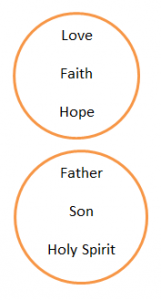 Saint John tells us that God is love (1 John 4:8). While he tells us this so that we are enabled to discern who belongs to God, we can also learn something of the nature of God. I’m going to do something that is often frowned upon in scripture interpretation; I’m going to apply a modern sensibility to John’s words. I’m going to look at John’s phrase, “God is love” the way I would evaluate a statement as a programmer and then I’m going to consider the fruitfulness of the result.
Saint John tells us that God is love (1 John 4:8). While he tells us this so that we are enabled to discern who belongs to God, we can also learn something of the nature of God. I’m going to do something that is often frowned upon in scripture interpretation; I’m going to apply a modern sensibility to John’s words. I’m going to look at John’s phrase, “God is love” the way I would evaluate a statement as a programmer and then I’m going to consider the fruitfulness of the result.
God is love can be expressed as God = Love. Is that what John meant; that there is an equality between God and love? Let’s take a look at a simple math problem and see if there is anything that fits with what John is saying. Let’s look at N=1. We do not know if the statement is true but let us, for the sake of this argument, say that it is true. What then, do we know about N=1? To answer that we need to define what 1 is; what we know about the number one. Well, one is an integer – meaning that it can be written without a decimal or fractional, which means that one is a whole or untouched number. One is also a natural number; that is, it is used for counting. In fact, one is the natural beginning of natural counting. One is the building block of all positive integers and as such, merits its own existence axiom in Peano’s axioms. One is the only multiplicative identity for all numbers; that is, one times any number is that number. One is the only perfect nth power for all positive integers. One is the only positive integer with exactly one positive divisor; itself. Simply summarized, one is a very unique number.
By the way, if any of these descriptions sound familiar, it may be because they also describe some of what we know about God. God is one God, not divisible even though there are three persons of the Holy Trinity. God, and in particular Jesus, is the one by whom all things are measured (Colossians 1:18-19). God is the one from whom all things came. He dwells in all of us (1 Corinthians 3:6-17). God is sufficient for His own being ((Aquinas’ proof of God’s existence from sufficient or efficient cause)). God is the Holiest of holies, unique in uniqueness, singularly singular (Deuteronomy 6:4-5).
| The Number One | God the Father |
|---|---|
| a whole or untouched number, not divisible by anything but itself | God is one God, not divisible even though there are three persons of the Holy Trinity |
| natural beginning of natural counting | the one by whom all things are measured |
| the building block of all positive integers | the one from whom all things came |
| merits its own existence axiom | sufficient for His own being |
| the only multiplicative identity for all numbers | dwells in all of us |
| one is a very unique number | God is the Holiest of holies, unique in uniqueness, singularly singular |
Now back to the number one – that’s a lot we can say about the number one. All these things we know about the number one, if the equation is true, we also know about the variable N, because N=1. Now, by the communicative property of mathematics, not only is N equal to one, but one is also equal to N, even though N and one may not be exactly the same. For instance, consider these expressions: 1=1, (1/1)=1, (1×1)=1, 11=1 (144,000/144,000)=1. … etc.
I can substitute 1 for anything on the left hand side of these equations and the equation will still be true. ‘N’ may be any of these expressions, which only differs in the way it is written; that is to say N is reducible to 1, such that the equation could read 1=1. Does that matter to a programmer? Yes, marginally – at least to me. There is always the elegance of the expression and the leanness of code to consider. Now, how to apply this sensibility to the expression God=Love.
Well, what do we know about love? More specifically, what does the New Testament tell us about love? From 1 Corinthians 13:4-13 we can write these equations (!= means not equal).
John 3:16 gives us the equation Love=Sacrifice.
I can substitute God for anything on the left hand side of these equations and the equations will still be true. It even works for the set of faith, hope and love if you compare the Holy Spirit with Faith ( 1 Corinthians 12:7-11, ), and Jesus with Hope (Matthew 12:21, Luke 24:21, Ephesians 1:12), and the father with Love (1 John 3:1, John 3:16, Regarding love greater than faith – John 14:28). In fact, these three virtues are called the Theological Virtues and are often referred to as a trinity. I have seen the Holy Trinity expressed like a Venn diagram with circles intertwining, overlapping and sometimes artistically designed with intricate weaving, or simplistically as one unbroken line or Mobius strip ( a single-sided object). Yet, I think the most accurate way to diagram the trinity of virtues or the Holy Trinity is to include their proper names in a single circle. If we want to be artistic, we can add some symbols to express each of the three persons.
Just as in describing the number one we came to understand N, so too in describing love we come to understand God. Do we understand everything about God? Nowhere near, and I imagine that we don’t understand everything about love either. But I tell you what; if you want to understand God better, endeavor to understand love better. And if you want to understand love, then love. God is the one who is (Exodus 3:14). And so love is in loving.

It was very interesting to read, thank you.
You are welcome. I appreciate your your acknowledgement as it encourages me to return to blogging again.